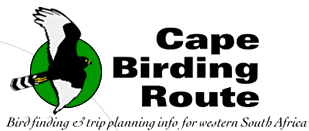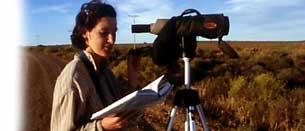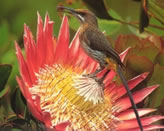|
|
| Introduction:
To the south of the Kalahari runs the Orange River, a powerful
passage of water cutting through the aridity of the Northern
Cape en route from its catchment in Lesotho’s alpine
reaches to its destination on the desolate Atlantic shoreline
(see p.101). Visitors approaching the Kalahari by road from
the south will need to pass through the regional centre of
Upington, sprawling along the river’s verdant banks.
A little to the west is the Augrabies Falls National Park,
where the river plunges into a magnificent gorge that it has
carved for itself through glistening granite. The birdlife
here displays an interesting mix of Karoo and Kalahari elements,
and well deserves exploration.
As
one moves southeast through the vast and varied area between
Upington and Kimberley, the provincial capital, the red sand,
yellow grass and sculpted acacias continue. Here, a selection
of bird species characteristic rather of South Africa’s
more wooded eastern regions add a tropical flavour to the
birding. Our focus will not be on these more peripheral species,
as they are much easier to find elsewhere, and we will concentrate
rather on the specials of the region. In recent years, birders
have been drawn to Kimberley in winter following the fascinating
discovery of a new species of migrant pipit, which has added
an exciting element of endemism to the already diverse birding.
Indeed,
the Kalahari receives the majority of its tourists during
winter, when the days are mild and cloaked by a resolutely
blue sky, and the nights often bitterly chilly. In the Kalahari
Gemsbok National Park, game is most visible at this time,
and conveniently concentrated in the accessible riverbeds.
During summer, the birdlife is augmented by a significant
migrant cohort, and the resident birds are more active, especially
after the late summer rains when the afternoon skies pile
up with spectacularly dark and forbidding thunderheads that
provide a dramatic backdrop to the lush veld.
Good
roads (mostly tarred) link all the sites described below,
and they can be easily combined with a loop through Bushmanland
(p.86). A very bare minimum of two full days should be devoted
to the park, although those with more time on their hands
will find a week or more successfully spent. The Upington
region and the Witsand Nature Reserve, in addition to being
good birding spots in their own right, provide pleasant staging
posts to break the otherwise gruelling full-day drives from
Cape Town to the entrance of the Kalahari Gemsbok National
Park, and from here to the Kimberley region. Visitors should
note that Kalahari distances are vast, and should take particular
care to allow sufficient travel time on unsurfaced roads (see
page on trip planning).
|
This website is maintained by Birding Africa.
Please do not use any text, images or content from this site without
permission.
© Birding Africa 1997-2009 info@capebirdingroute.org
4 Crassula Way, Pinelands, 7405, Cape Town, South Africa
|

27/09/09: Dalton
Gibbs reports back from Gough
Island! Read the blog!
26/09/09: New Cape
Town Pelagics trip report from trips of 12 and 19 September
2009.
30/08/09: British
Birdwatching Fair at Rutland Water proved very successful,
with sunny weather and over 20,000 visitors. Callan's "Birding
Namibia and the Okavango" was the most highly-attended
lecture on the Saturday, with over 240 people. Congratulations
to the winners of the Birding Africa competition and the
African Bird Club raffle that we helped sponsor!
12/08/09: New Cape
Town Pelagics trip reports from August and July 2009.
Highlights: Little
Shearwater and more!
07/08/09: The
sub-adult Black Sarrowhawk visits our garden again! Read
on about Raptor Research in the Western Cape.
27/07/09: Cape
Town's Verreauxs' Eagle Chick has grown! And its sibling
never had a chance to hatch. See the pictures of the chick,
its nest and the breeding pair. Find out more about the Western
Cape Raptor Research Programme.
27/07/09: To follow modern nomenclature and systematics, we've
adopted the IOC
World Bird List, Version 2.1.
13/07/09: The 8th
African Bird ID Challenge has launched! Win a 50% discount
on a Cape Town Pelagics
trip, a copy of Southern
African Birdfinder, or African
Bird Club membership for 1 year.
6 July 09: Cape
White-eye research in our garden.
2 July 09: Cape
Town's Verreauxs' Eagle Chick has hatched! See the pictures
of the chick, its nest and the breeding pair. Find out more
about the Western Cape Raptor Research Programme.
2 July 09: Campbell
Fleming, a Cape Town scholar, avid birder and photographer,
joined Birding Africa last month as an intern. Click here,
to see what he got up to.
2 July 09: New pelagic
trip reports from the Cape Town Pelagics trips in June
2009. Highlights: Slenderbilled
Prion and Leach's Storm Petrel
30 july 09: Our latest Cape Fynbos and Karoo trip
reports feature Hottentot
Buttonquail, Cinnamon-breasted
Warbler and other fynbos and Karoo endemics...
26 June 09: Tungsten
mining threatens RAMSAR site, South Africa's Verlorenvlei.
Read the Media Release.
22 June 09: Claire
Spottiswoode, one of the Cape Birding Route founders,
was part of the exploratory team at Mount Mabu. The mountain
is part of the newly discovered largest
rainforest in Southern Africa.
11 June 09: A colour-ringed
Black Sparrowhawk visits the Birding Africa office garden.
Read why it's a 10 months old male!
14 June 09:
Wildlife
at the office of The Cape Birding Route, Birding Africa
and Cape Town Pelagics.
31 May 09:
Michel Watelet wins the 7th African Bird Club & Birding Africa
ID Challenge. Test your African birding skills and WIN
a Birding
Africa Cape town day trip or a copy of the Birdfinder!
30 May 09:
A tragedy unfolds at Kommetjie south of Cape town as 44 beached
False
Killer Whales were shot. Click here for more details and
pictures.
14 March 09: Raptor
Watch in Cape Town on 14 March 09
|
|


